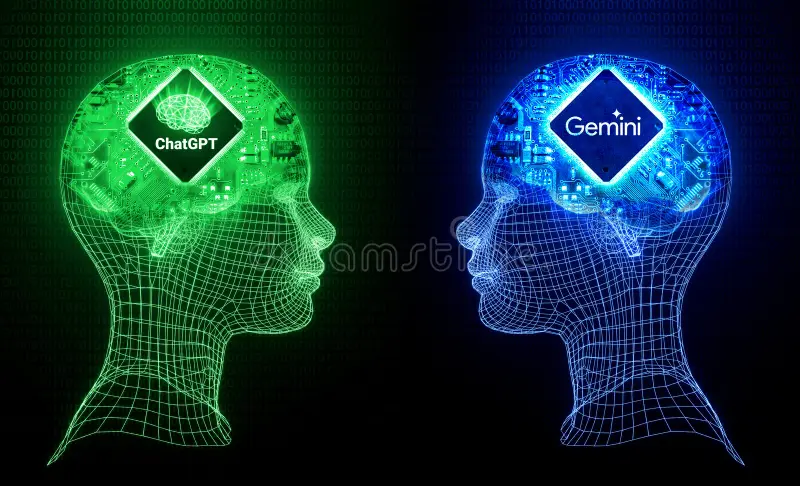Why ChatGPT Won the Marketing Game (Even If It’s Not the Best AI)
In the fascinating world of artificial intelligence, raw technical power doesn’t always translate to market dominance. We’ve seen it time and time again; sometimes the better mouse trap isn’t the one everyone ends up buying. So why has ChatGPT, often regarded as technologically inferior to Google’s Gemini, captured the public’s attention and become a household name? It’s not all about the tech, folks. Today, we’re diving into the world of AI marketing to explore the key marketing and branding decisions that have propelled ChatGPT into the spotlight, while shedding light on where Google’s approach may have missed a step.
The First-Mover Advantage and Brand Recognition in AI
Let’s face it, when it comes to new technology, there’s a huge benefit to being first. ChatGPT had a crucial first-mover advantage, capturing the market’s attention before any other conversational AI had a chance to shine. It wasn’t just about being early, though. The initial release of ChatGPT created a sense of wonder, like opening a magical box of digital goodies. This “aha!” moment drove a lot of viral marketing and helped with early adoption, making ChatGPT not only easy to recognize but also super cool. Because of that, people have developed a really strong brand recognition with ChatGPT that’s hard to beat!
Marketing Strategy, Brand Messaging, and the AI Hype
When it comes to how you present your product, the right marketing strategy is like the secret sauce for success. OpenAI focused on making ChatGPT sound revolutionary, emphasizing the transformative power of AI. Their brand messaging tapped into our curiosity, making people excited about the possibilities. Google, on the other hand, took a more technical approach. They focused on the nitty-gritty details of their model. While impressive, their marketing lacked that emotional connection. This was a battle of tech versus hype, and in this case, the AI hype won.
Perception of Innovation: Challenger vs. Incumbent
There’s a certain thrill when a new player enters the scene, and this is especially true in the tech world. OpenAI was perceived as a challenger brand – a disruptor breaking the established order. Google, meanwhile, was the incumbent – the big tech giant everyone already knew. This “David vs. Goliath” dynamic played a huge role in the public’s perception of innovation. People love an underdog story, and this sentiment made the public more inclined to try out the newcomer’s product.
User Experience, User Interface (UI) & Accessibility
Sometimes the simplest approach wins, and that was the case when it came to user experience and user interface. ChatGPT had a beautifully simple UI, making it super easy for anyone to jump in and start having conversations. It didn’t require a Ph.D. in computer science to use. On the other hand, Google’s approach was more complex. Gemini was incorporated into their existing products, which made it feel less like a revolutionary new product and more like a new feature within Google’s ecosystem. Sometimes, when it comes to technology, accessibility is key to widespread adoption.
Public Relations and the Technology Hype
OpenAI did an incredible job with public relations. They were all about the technology hype and getting people talking. Their PR strategy included press releases, strategic partnerships, and lots of demos that had users going wow! Google’s more measured approach meant less media coverage and, as a result, less hype. In the AI arena, creating a buzz is half the battle!
Product Focus: Conversational AI & a Wide Portfolio
When it came to product focus, ChatGPT was designed to nail conversational AI. It was built to make interactions feel seamless and natural, like chatting with a smart buddy. Google, however, had a wider portfolio to think about. Their product management strategy involved using Gemini in their many existing products. The more general approach might not have allowed users to see what Gemini was truly capable of.
The “Cool Factor” and The Power of Word-of-Mouth Marketing
Sometimes, it’s not enough to be smart; you have to be cool, too! ChatGPT had the cool factor that made it instantly popular. Content creators, students, and tech enthusiasts all jumped on the bandwagon. As more people used it and talked about it, word of mouth did its magic, creating a positive viral loop. It just had that extra umph that made users want to share it, tweet about it, or post it on their TikTok channels.
The Bard Blunder: Google’s Rushed Response
In their haste to catch up with OpenAI, Google rushed the release of Bard, their conversational AI model. This move, while understandable from a competitive perspective, resulted in a product that was not as polished or well-received as ChatGPT. The initial release of Bard was plagued with errors and inaccuracies, which caused a negative perception. This misstep undermined Google’s reputation in the AI race and highlighted the importance of taking the time to refine a product before its public release. Sometimes, slow and steady wins the race; and sometimes, it’s good to hold your horses.
The Importance of Strategic Marketing and Brand Building
The case of ChatGPT versus Gemini shows that even the most superior product needs a solid marketing strategy to get ahead. Remember that strategic marketing and effective branding are just as important as innovation. The product that wins isn’t always the best one. In the end, it’s how people view your product and how well your marketing impact is that counts. People are more likely to engage with a product that feels exciting and innovative.
Conclusion: What This Means For Tech Companies
The story of ChatGPT and Gemini teaches us a valuable lesson. You can create the most innovative product in the world, but if you don’t have the right marketing approach, you may not reach your intended audience. Public perception, a well-crafted story, and the power of good old-fashioned hype can make or break a brand. Sometimes, you can be a challenger that wins it all with its storytelling and the impact of its messaging. The market doesn’t always gravitate towards the technically superior product, but the brand that has the best audience engagement with customers. And remember, the cool factor counts.


